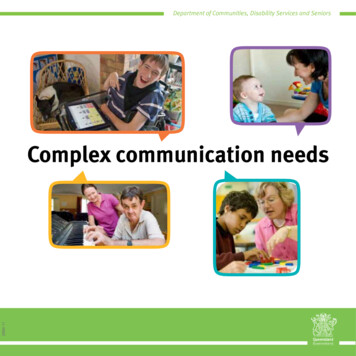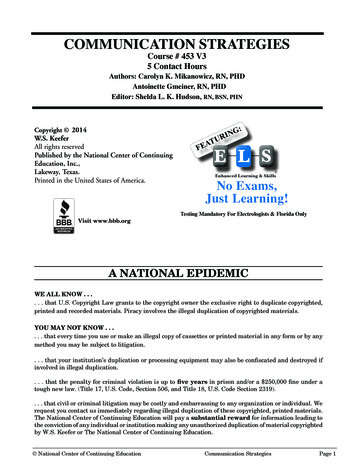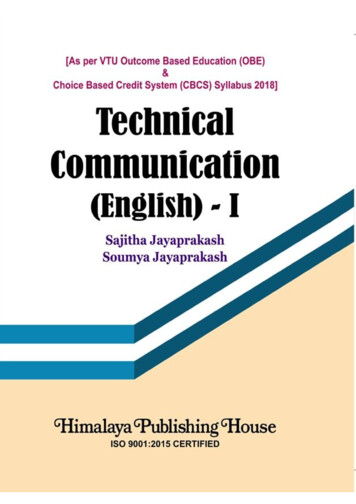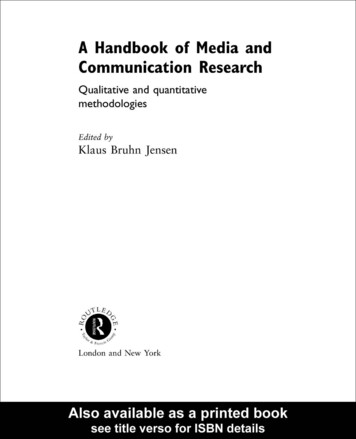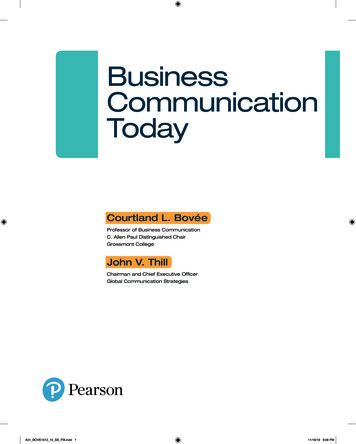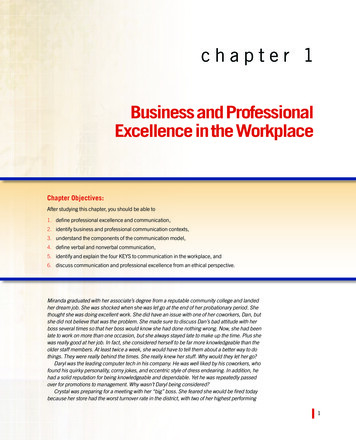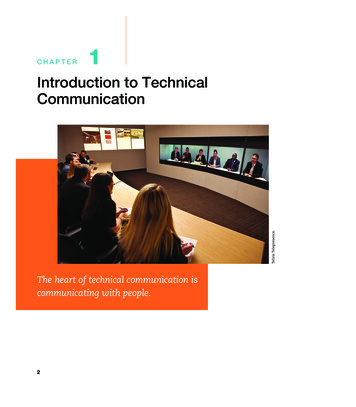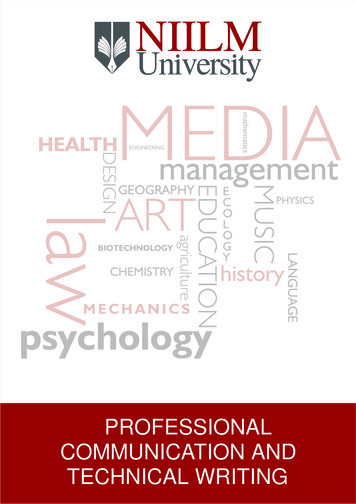
Transcription
entHEALTHPROFESSIONALCOMMUNICATION ANDTECHNICAL WRITING
Subject: PROFESSIONAL COMMUNICATION AND TECHNICAL REPORT WRITINGCredits: 4SYLLABUSCommunicationWhat is communication-meaning ,importance, dimensions & channels, Barriers of communication, Effectivecommunication- Essentials of good communication, Types of communication- verbal(oral & written)&nonverbal.Technical Written CommunicationNature, origin and development of technical written communication. Salient features. Difference betweentechnical writing and general writing.Pre-requisites of Scientific and Technical CommunicationFragmented sentences,Parallel comparisons, Elements of a series, Squinting construction and split infinitive,Modifiers, connectives and clause subordination,Dangling participles and gerunds,Coherence, Unity,chronological method, spatial method, inductive method, linear method, deductive method, interrupted method,Preparation of summaries.Business CorrespondentGeneral principles of business correspondence, Ramifications of business letters, Letters giving instructions,inquiries and answers to enquiries, complaints and adjustments, letters urging action, employment letters,application and resumes, Circulars, Notices, E-mails.Proposal writingProposal: Definition and kinds, Division of format proposals (front matter, title page, summary/abstract, Tableof contents etc.) Statement of request, body-statement of problem, background, scope, methodology,Advantages and disadvantages.Writing Scientific and Semi-technical articlesSource material, topic sentence, literature review, Tables, figures, footnotes, bibliography.Report WritingCharacteristics of business reports, Structure of reports: font matter, main body, back matter, Style of Reports:Definition, the Scientific Attitude, Readability of Reports, Choice of Words of Phrases, Construction and lengthof Sentences, Construction and length of Paragraphs. The line-out or break up of a format report, MemorandumForm Report, Periodic Report, Miscellaneous Report.Oral CommunicationInterview, Techniques of conducting Group Discussions, Oral Presentations, Telephonic Communication.List of PracticalsPractice session of oral communication by means of seminars on current topics, debates and contests, discussionSession, Practice of writing official business and personnel letters,3. Practice of handling telephoniccommunication Practice of technical report writing, Practice of writing personnel biodata and writing,application for a job, Practice session on group discussion.
Suggested Reading:1.2.3.4.5.Sherman, Theodore A. (et.al.)- Modern Technical Writing, (Apprentice Hall, New JerseyLegget, Glenn (et. al)-Essentials of Grammar and Composition (Macmillan, DelhiStrunk, Jr., William (et. al)- The Elements of Style,(MacmillanSharma, S.D.-A Text book of Scientific and Technical Writing, (Vikas, Delhi,O’Conner, J. D. Better-English Pronunciation, James Daniel-English PronouncingDictionary, (J. M.Dent, London, .
PROFESSIONAL COMMUNICATION AND TECHNICAL WRITINGPROFESSIONAL COMMUNICATIONAND TECHNICAL WRITINGCOURSE OVERVIEWThis course is designed to prepare you in the methods andObjectivesforms of communication used in business and professionalWe will examine concepts including, but not limited to:environments, with special attention paid to the new demands Why technical communication is an area worth studying;of electronicÊ communication skills in a marketplace still How to name, learn about, and approach an audience,dominated by the printed page.hether it be an audience of one or of many, a familiarAccording to departmental and institutional guidelines,audience or an unknown quantity;Technical and Professional Communication addresses the kinds What the important differences are among and betweenof writing and speaking, students will encounter on the job andvarious types of media and how writing to those media canincorporates . practices that have proven to help students of allplace different demands on the construction of anargument;kinds to improve their writing and speaking . The mix oftechnical and communication professionals in the same course Usage, Grammar) writer;will help each to work with managers, for example, and all ofthese technical professionals to work with communicationHow to become a perfectly SMUG (Spelling, Mechanics, Incorporating the reporter’s “5 W’s an H” (Who, What,professionals.When, Where, Why and How) into planning andWe will spend the first part of class learning a shared terminol-presentation, and examining that often-neglected questionogy and exploring enough theory to give us a common. “so what?”vocabulary. We will then venture into the tasks of identifying Revising and re-writing with a focus on sailing the 7 C’s .and naming the kinds of technical communication tasks specificCompleteness, Conciseness, Concreteness, Consideration,to your individual major(s) and creating ways to practice andCourtesy, Clarity and Correctness.develop skills pertinent to those tasks AssignmentsAssignments will be tailored to address these concepts; as theclass develops and proceeds, we may well find ourselvesfocusing on one or two of them above and beyond the others.i
PROFESSIONAL COMMUNICATION AND TECHNICAL WRITINGThat is, of course, the way the standard workplace functions -5. Think from your audience point of view.we will discover what interests us most, what we are best at, and6. Be mindful of what you face and body are conveyingwe will work at those things to produce documents whichreflect that focus. If at any time during the semester you have anidea for an alternative assignment which would help you moreprofessionally than one of those designed and presented, feelfree to “pitch” that idea, not only to the instructor, but to theclass as a whole for feedback.The Four Main Goals of Communication1. To Inform - You are providing information for use indecision making, but aren’t necessarily advocating a courseof action.2. To Request - For a specific action by the receiver3. To Persuade - To reinforce or change a receiver’s beliefabout a topic and, possibly, act on the belief4. To Build Relationships - Some messages you send mayhave the simple goal of building good-will between youand the receiverKFC - The Three Aspects of SuccessfulCommunication7 Know what you want Find out what you are getting Change what you do until you get what you wantEffective Communication Achieves shared understanding Directs the flow of information Helps people overcome barriers to open discussion Stimulates others to take action to active goals Channels information to encourage people to think in newways and to act more effectivelyThe 10 Essentials of Effective Communication1. Know your audience and match your message to theaudience.2. Respect your audience and suspend judgments.3. Know exactly what you want to achieve.4. Think and organize before you proceed.iinonverbally.7. Listen carefully to all responses.8. Be willing to share what you know and hear what you don’tknow.9. Stay focused on what you want to achieve and don’t getdistracted.10. Find a way to get your audience to explain what they thinkyou said. Discuss differences until you hear a satisfactoryversion of the message you wanted to convey.
PROFESSIONAL COMMUNICATION AND TECHNICAL WRITINGPROFESSIONAL COMMUNICATIONAND TECHNICAL WRITINGCONTENT.Lesson No.TopicLesson PlanPage No.viProfessional Communication And Technical WritingivLesson 1Meaning and Definition of Communication1Lesson 2Dimensions of Communication7Lesson 3Barriers of Comunication12Lesson 4Effective of Communication16Lesson 5Importance of Verbalization or use of Words19Lesson 6Verbal Communication : Written22Lesson 7Non Verbal Communication: Kinesics or body Language25Lesson 8Nature , Origin and Art of Technical writing29Lesson 9Characteristics of Technical Writing32Lesson 10Technical Writing Style35Lesson 11Difference between Technical and General Writing42Lesson 12Fragmented and Parallel Sentences45Lesson 13Elements of a Series47Lesson 14Coherence and Unity51Lesson 15Summarising or Precis Writing53Lesson 16General Principles of Business Correspondence58Lesson 17Letter Writing - Ramification62Lesson 18Business Correspondence - Application Letters69Lesson 19Circular And Questionnaires75Lesson 20E-mail78Lesson 21Definition and Kinds of Proposal89Lesson 22Details of Format92Lesson 23Practice Session for Proposal Writing97Lesson 24Writing Scientific and Semi Technical Articles99
PROFESSIONAL COMMUNICATION AND TECHNICAL WRITINGPROFESSIONAL COMMUNICATIONAND TECHNICAL WRITINGCONTENT.Lesson No.TopicPage No.Lesson 25Importance of Graphics106Lesson 26Characteristics of Report Writing112Lesson 27Style of Report Writing116Lesson 28Classification of Reports119Lesson 29Practice of Writing Technical Reports123Lesson 30Interview124Lesson 31Practice Session131Lesson 32Techniques of Conducting Group Discussions133Lesson 33Practice Session (Contd.)136Lesson 34Oral Presentations137Lesson 35Practice Session (Contd.)140Lesson 36Telephonic Communicatio141Lesson 37Practice Session (Contd.)147v
LESSON 1:MEANING AND DEFINITION OFCOMMUNICATIONUNIT ICHAPTER 1: COMMUNICATIONWe all use the word ‘communication’ often in our daily lives.We generally say there was a communication gap when misunderstandings occur or when we play the game ‘chinese whisper’.I am sure you must have played this game during yourchildhood. You must have noticed that when we whisper aphrase for example ‘why are you unhappy’ , by the time itreaches the last person he might hear it as ‘change his nappy’. Soyou see if communication is not proper the meaning altogetherchanges. We should be able to convey the exact meaning ofwhat we say.CommunicationObjectives1.Understand the importance of becoming an effectivebusiness communicator in today’s changing workplace.2.Examine the process of communication.3.Discuss how to become an effective listener.4.Analyze nonverbal communication and explain techniquesfor improving nonverbal communication skills.5.Explain how culture affects communication and describemethods for improving cross-cultural communication.6.Identify specific techniques that improve effectivecommunication among diverse workplace audiencesNow tell me what do you understand by the word ‘communication’?Most of the time we are in one situation or another thatinvolves communication. Even then it is worthwhile to makean attempt to understand the exact meaning and nature of thismost important activity of ours. The word ‘ communicatecomes from the Latin verb. ‘communicare’ that means toimpart, to participate, to share or to make common. By virtueof its Latin origin it is also the source of the English word‘common’. Whatever is common is shared by all. Hence thesense of ‘sharing’ is inherent in the very origin and nature ofcommunication.Communication is, indeed, sharing; sharing of ideas andfeelings between two or more persons. We, the human beings,being social creatures, do need to convert our ideas to ourfriends, neighbours, colleagues and subordinates. This activityof sharing our mind with others may take place for severalpurposes. It may be an order, an advise, a reprimand, aninformation, a question and so on. Since communicationpresupposes a definite objective, it has its won science and art.One must learn and practice the skill of effective communication in order to succeed in the modern world.And, what is it that we share in communication? The oneword answer is – ‘information’, i.e., some thing to tell, inwhatever way we like, or, as the situation demands.Why is communication important in society ?Social AspectIt is, in this way, a social activity. In society we share ourthoughts, feelings, emotions, reactions, propositions, facts andfigures with individuals as well as group at all levels, higher,lower or equal. Communication is, in fact, the most importantof all our activities it has helped us to organize ourselves as acivilized society. In a civilized society there are well-defined rolesfor all and one. The only way to play these roles is throughcommunication. All communications is based on, and is guidedby role-relationships. Only when we understand and appreciate these role-relationships can we successfully communicate. Inthe words of John Adair “Communication is essentially the1PROFESSIONAL COMMUNICATION AND TECHNICAL WRITINGMeaning and Definition ofCommunication
PROFESSIONAL COMMUNICATION AND TECHNICAL WRITINGability of one person to make contact with another and tomake himself or herself understood. Or, if you prefer aslightly more formal version, communication is theprocess by which meanings are exchanged between peoplethrough the use of a common set of symbols”.Ingredients of CommunicationThe important words to note in the definitions given above are Process Meaning Exchange People Common set of symbols.A process, by definition or simple explanation, is ‘a systematicseries of actions, operation of series of change directed to someend.” The process of communication leads to a desired resultas, for example, in the execution of an order, production of areport, a telephone conversation, a memorandum etc. If wethink seriously about this process and try to isolate its ingredients we get the following picture.Key ElementsNotesParticipantsThe persons who are communicating haveto be in touch with each other.Medium orBoth parties to communication must sharecommona common language or means oflanguagecommunicationTransmissionThe message has to be imparted clearly.of theinformationDecoding orThe message has to be received properly,Understandingunderstood and interpreted.It means, therefore, that in the process of communication twoor more person must participate through a medium that carriesthe information or message for a particular purpose mutuallyunderstood by both the sender and the receiver. Only whenthese conditions are fulfilled a significant communicativesituation will take shape and what transpires between the twoparties, viz., the sender and the receiver, whether spoken orwritten, will be the communicative event. The importance thesecommunicative events cannot be over-emphasized. They arethe very lifeline of any organization.An American woman tourist was at the New York Customs.She was returning from Sri Lanka where she had gone on ashort holiday. She was wearing a kaftan that she had picked upfrom the exotic island.The Custom Officer took her passport and without botheringto open it asked her ‘what’s your occupation?’ The touristhesitated for a moment. She was a housewife; she didn’t knowwhat to say. There was a time when a woman could cheerfullyannounce that she was a housewife. But that was no morefashionable. Well after what appeared to be a brief struggle inher mind she answered, ‘None’.The officer found nothing objectionable. He returned herpassport and indicated that she could go. She didn’t. Insteadshe asked, Officer! If you don’t mind, I’d like to ask you a2question. Why did you search my luggage so thoroughly?You’ve taken more than half an hour and I’ve missed myconnecting flight. Is it that you pick on people at random andgive them hell?’‘No lady’, answered the officer, ‘but I couldn’t believe your storythat you were a nun.’This is a real incident the woman herself reported a few yearsago in Readers Digest. The tourist and the officer heard eachother very well. As both spoke American English as theirmother tongue, there could not have been any linguisticdifficulty with the simple question and answer that passedbetween them in English. Yet the officer mistook her thoroughly. It caused both of them inconvenience. What preventedthe officer from decoding the woman’s answer correctly?The answer lies in the way we communicate.How do we communicate?The Communication ProcessAlthough all of us have been communicating with others sinceour infancy, the process of transmitting information from anindividual (or group) to another is a very complex process withmany sources of potential error.Consider the simple example: Terry: “I won’t make it to work again tomorrow; thisillness keeps me nausious and my doctor says I shouldprobably be reduced to part time. Boss: Terry, this is the third day you’ve missed and yourappointments keep backing up; we have to cover for youand this is messing all of us up.Message to be sentdecodeencoded by receiversome error likely some error likely)message receivedIn any communication at least some of the “meaning” lost insimple transmission of a message from the sender to thereceiver. In many situations a lot of the true message is lost andthe message that is heard is often far different than the oneintended. This is most obvious in cross-cultural situationswhere language is an issue. But it is also common amongpeople of the same culture.Look at the example. Terry has what appears to be a simplemessage to convey-she won’t make it to work today because ofnausea. But she had to translate the thoughts into words andthis is the first potential source of error. Was she just trying toconvey that she would be late; was she trying to convey anythingelse. It turns out she was. She was upset because she perceivedthat her co-workers weren’t as sympathetic to her situation asthey should be. Her co-workers, however, were really beingpressured by Terry’s continued absences, and her late calls. Theywished she would just take a leave of absence, but Terry refusesbecause she would have to take it without pay.Thus what appears to be a simple communication is, in reality,quite complex. Terry is communicating far more than that shewould miss work; she is conveying a number of complexemotions, complicated by her own complex feelings aboutillness, work, and her future.
Similarly, the boss goes through a complex communicationprocess in “hearing” the message. The message that Terry senthad to be decoded and given meaning. There are many ways todecode the simple message that Terry gave and the way themessage is heard will influence the response to Terry.In this case the boss heard far more than a simple message thatTerry won’t be at work today. The boss “heard” hostility fromTerry, indifference, lack of consideration, among other emotions. Terry may not have meant this, but this is what the bossheard.There is general agreement Communications is so difficultbecause at each step in the process there major potential forerror. By the time a message gets from a sender to a receiverthere are four basic places where transmission errors can takeplace and at each place, there are a multitude of potential sourcesof error. Thus it is no surprise that social psychologists estimatethat there is usually a 40-60% loss of meaning in the transmission of messages from sender to receiver.It is critical to understand this process, understand and beaware of the potential sources of errors and constantly counteract these tendencies by making a conscientious effort to makesure there is a minimal loss of meaning in your conversation .Itis also very important to understand that a majoring ofcommunication is non-verbal. This means that when weattribute meaning to what someone else is saying, the verbalpart of the message actually means less than the non-verbalpart. The non-verbal part includes such things as body languageand tone.From the foregoing discussion it becomes amply clear that manis born to communicate. In other words, communication is anecessary condition of human existence and social organization.But the importance of communication in business organization came to be realized quite late. Traditionally it was regardedas a taken-for-granted affair. However, over the last half centuryor so serious studies and experiments have shown that everyorganization is a society in which there are people operating atto achieve common goals proper interaction between andamongst them is, therefore, a must.Part of the Process of ChangeIn this connection it is important to note that the world ischanging fast, and with it every organization is becoming moreand more sophisticated. So, communication has first of all tobe given due recognition as an integral part of the process ofchange. Whenever a change in the direction of technology,structures, objectives etc is called for it becomes easier with thehelp of communication. Most of the management problemsarise because of lack of effective communication. If thecommunication system is properly devised the chances ofmisrepresentation or misunderstanding are minimized. If themanager are not ware of the relations and feelings of theirsubordinates their planning will collapse and numerousobstacle will crop up. Today, technology is highly advanced andthe people are suppose to be up to date in every respect. Butundue emphasis on profit motive lead to many complication,first and foremost of them being the human problems. Theyare far more critical than the technological problems. It iscommunication that helps solve these problems. In the wordsof Allen, “Communication involves a systematic andcontinuous process of telling, listening and understanding” There is general agreement that we can’t share ourthoughts and ideas directly with others. We adopt a process ofcoding and decoding. It goes like this. I feel like eating jelebies.How do I communicate this to my mother? I put this thought into averbal code and transmit it through the oral channel:” Momma can youmake some roundies?” Momma is the code accepted by everyone at homefor “mother”. So when I say “Momma” my mother knows I am callingher rather than father or sister or brother. When I say “can you make”,I am using one of the codes available to stand for a polite request. And“roundies” is the code we have at home for jelebies. So mother decodes myrequest accurately. If a guest happens to be around, he will be able todecode only a part of it, that is, I am asking my mother to makesomething. He cant go much further than that with any certaintybecause he doesn’t know what roundies is a code for at home.Knowledge of the code – usually language- helps one codeones message for others and decode others messages. Poorknowledge of the code can make the process of coding anddecoding defective. This will impair communication.Consider the games we play with communication. Consider theroundabout way in which we generally communicate. Lets seehow many different meanings can be projected through thesimple sentence “ Pankaj the door is open”. Here are few. Wecan read several more meanings into that string of five words ifwe put it in different contexts. Please come in. Please leave. I am not holding you back. Lets go in. Please close the door. Why didn’t you close the door? ( How many times I haveasked you to?) The maid has been careless again. What a stroke of luck! We don’t need to break it. Speak softly; someone might hear what you are saying.Why do we say ‘ Pankaj, the door is open’, when we can clearlysay’ Pankaj I am angry that you didn’t close the door, or Pankaj,please close the door’? There seems to be something more tocommunication than coding our message and expecting othersto decode it correctly. Perhaps we want our messages to be clearbut not so clear that nothing is left to imagination. Perhaps wedon’t want our messages to be open that there is no escaperoute if we change our mind. Perhaps we are not very clearabout our own messages. We are quite used to vagueness andambiguities in others and ourselves. Life would be boring ifeverybody was an open book. Our communicative behaviourensuresThat there will always be suspense.3PROFESSIONAL COMMUNICATION AND TECHNICAL WRITINGShe sent a message but the message is more than the words; itincludes the tone, the timing of the call, and the way sheexpressed herself.
PROFESSIONAL COMMUNICATION AND TECHNICAL WRITINGAfter all this discussion what do you feel is the purpose ofInternal and External communication ?Purpose of Internal CommunicationTaking all these factors into account we realize that no organization can function satisfactory or achieve its goals withouteffective communication that operates both internal andexternally. Internally it is important because it integrates themanagerial functions. The most important of these functionsare:(i) Establishing and dissemination of the goals of anenterprise.(ii) Development plans for their achievement.(iii) Organizing human and other resources in the mosteffective and efficient way.(iv) Selecting, developing and appraising members of theorganization.(v) Leading, directing, motivating and creating a climate inwhich people want to contribute their best, and(vi) Controlling performance.Purpose of External CommunicationExternally, communication relates an enterprise to the environment outside. It is though information exchange that managersbecome aware of the needs of customer, the availability ofsuppliers, the claims of stock-holders, the regulation ofgovernments, and the concerns of a community. It is throughcommunication that any organization becomes an open systeminteracting with its environment and responds to it fruitfully,purposefully and desirably. Just to take one example, it cannotbe forgotten that the customer, who is the most importantentity for all business, exists outside a company. It is throughthe communication system that the needs of the customers areidentified. The knowledge of his need enables the company toprovide products and services profitably. In the same way, it isthrough effective communication that the organizationbecomes aware of competition and other potential; threats andconstraining factors. After all, no enterprise can thrive in avacuum.Now it must be clear how important effective communicationis. It is the very life blood of all business. No communication,no business. Even then very often problems, serious and notso serious, arise because of something going wrong in communication. Thee are innumerable instances ofmiscommunication, miscommunication, incomplete communication, misconstructed communication and so on. Managersoften complain about communication breakdowns as one oftheir most important problem. Specialists in the field havemade serious studies regarding these problems and come upwith useful insights into what have widely come to be knownas ‘barriers’ to communication.Before we go into these barriers it is worthwhile to haveanother, closer look at the process of communication. In thevery beginning of this book communication has been definedas a “process by which meanings are exchanged between peoplethough the use of a common set of symbols.” A schematic or4diagrammatic representation of this process is very much inorder at this juncture. It can be shown as ingEncodingSender’s levelTransmission ofmessageUnderstand-ingReceptionReceiver’s LevelNoiseFeatures of CommunicationWhatever the form or situation or event, all communication hassome clearly identifiable features that can be stated as follows:(a) In the first place, communication is meaning-based. Ashas been very succinctly said by a specialist, “The mostimmediate need for communication is to be able to refer toa core of basic referents or things in the real world, that is,to be able to name things, states, events, attributes, usingthe words he or she knows”. In addition, we must be ableto link words together so as to make propositions. Hence,the need to be clear-headed about what we want to say.(b) Secondly, it is important to note that all communicationis conventional and, to a large extent, tradition-bound. AsEnglish, for example, dominates business worldwide, it isnot only necessary for us to imbibe the conventions ofEnglish speech and writing, but also the time-honouredtraditions’ of the organization to which we belong,whether a multinational corporation or traditional Indianfamily-owned organization or government AdministrativeStaff College of India, “The relationship incommunication provides a context for interaction. Inalmost all cases over time, the relationship between peopleexpansively spreads beyond the functional interaction,encompassing other areas of their behaviour and life. Thisleads to communication relationships that begin at thepoint of function, and then work beyond it”.(c) Thirdly, all communication is interactional. It is the use oflanguage to keep open the channels of communicationbetween people and to establish suitable rapport. It is thusaimed largely at the need of speaker and hearer, or writer orreceiver, to feel valued and approved of.(d) Fourthly, communication is always supposed to beappropriate. In all its forms it must take into account therelationship between speaker/writer and hearer/receiver,and the constraints imposed by the setting andcircumstances, and selection of language/style/toneaccording to the age, rank and status of the participants inthe communicative event. This will further depend on suchfactors as the age, sex, familiarity, and roles of speaker andhearer, or writer and receiver, which will determine whethera speaker adopts ‘conversational’ strategies implying either‘affiliation’ or ‘dominance’, or in other words, the languagehe uses gives indications of his hierarchical status.
Equally important is the difference between the purposes of thetwo letters beyond the shared superficial intent of providinginformation about success or failure of the application. The‘good news’ letter will be constructed in such a way that thecontinuation of the correspondence is encouraged, whereas theother one will be designed to terminate the correspondence bygiving the unlucky recipient the least possible scope for objection or complaint.There is another level of structure that we may call processstructure. When we talk or write, much of what we transmit ismade up of words or phrases which indicate how what we arcgoing to say relates t
Technical Written Communication Nature, origin and development of technical written communication. Salient features. Difference between technical writing and general writing. Pre-requisites of Scientific and Technical Communication Fragmented sentences,Parallel comparisons, Elements

